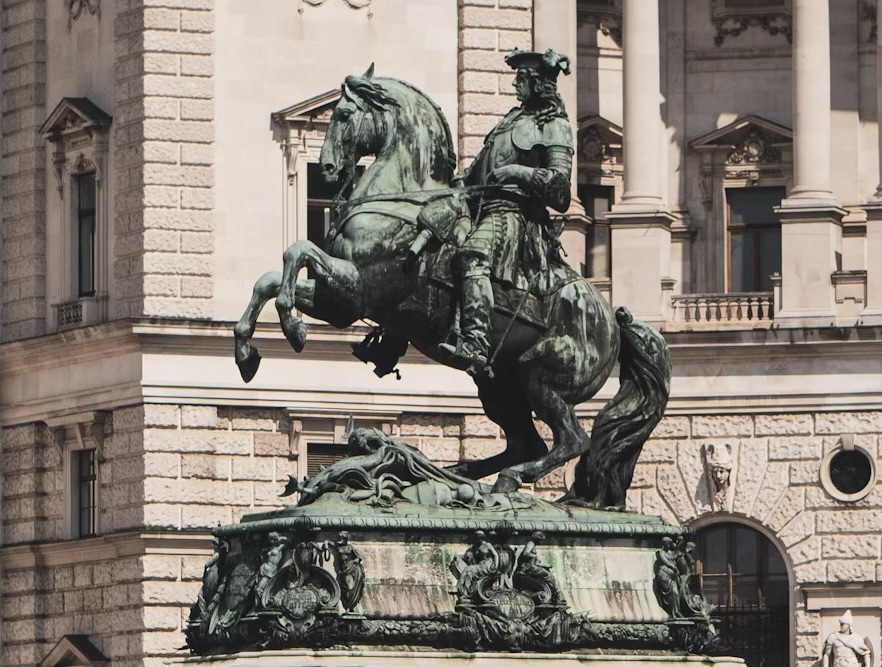Experience Travel Insights
Prinz Eugen Belvedere: From a Warrior Prince’s Palace to the Home of “The Kiss”
by Long Lin-Maurer • September 24, 2025

The Prinz Eugen Belvedere: A Prince’s Vision in Stone and Story
Vienna’s skyline is a conversation between centuries, a dialogue of imperial ambition, artistic revolution, and resilient spirit. Among its most eloquent speakers are the twin palaces of Belvedere, collectively known as the Prinz Eugen Belvedere. To truly understand this iconic Viennese landmark is to understand the man who willed it into existence: Prince Eugene of Savoy. This is not merely a palace; it is the autobiography of a brilliant military commander, a master diplomat, and one of history’s most discerning art collectors. The Schloss Belvedere is a stage for power and a sanctuary for beauty that continues to narrate the epic tale of Central Europe and its rich Vienna history.
The Man Behind the Palace: Prince Eugene of Savoy’s Rise
The story of the Belvedere begins not in Vienna, but in the court of Louis XIV’s France. Born in Paris to a high-ranking general of the House of Savoy-Carignano, the young Eugene was small, unassuming, and destined for a career in the church. When the Sun King denied him a military commission, mocking his slight stature, he made a decision that would alter the course of European history. He renounced his French allegiance and offered his sword to France’s greatest rival: the Habsburg Holy Roman Emperor Leopold I in Vienna.
Come and experience travel!
Personally designed, seamlessly delivered – your journey, our expertise!
We are a boutique travel agency and consultancy specializing in Hub & Spoke Tours across Central Europe, the Benelux and the Dolomites.
It was a gamble that paid off spectacularly. Eugene arrived in a Vienna under siege by the Ottoman Empire in 1683. His tactical brilliance and fearless leadership quickly became apparent. Over the next three decades, he rose to become the most formidable military commander of his age, securing the Habsburg domains against both Ottoman expansion in the east and French ambitions in the west. His victories at Zenta, Blenheim, and Turin are legendary. He was more than a soldier; he was the shield of the empire, a statesman who navigated the treacherous currents of European politics with the same acumen he displayed on the battlefield. With his immense wealth, derived from military spoils and imperial rewards, he set out to build Prince Eugene’s summer residence, a project that would reflect not just his status, but his sophisticated, pan-European worldview.
The Belvedere Complex: A Symphony in Baroque Architecture
For his summer residence, Prince Eugene chose a plot of land outside the then-city walls, a sloping terrain that his brilliant architect, Johann Lukas von Hildebrandt, would transform into a theatrical masterpiece. The Belvedere complex is not a single building but a cohesive ensemble, a concept known as a Gartenpalais (garden palace). It consists of two separate palaces—the Lower Belvedere and Upper Belvedere—connected by a magnificent, terraced garden that serves as both a physical and symbolic link.
The design is a masterclass in Baroque symbolism. The journey from the Lower Belvedere uphill to the Upper Belvedere is an allegorical ascent, mirroring Eugene’s own rise from a disregarded nobleman to the most powerful man in the empire. The gardens, with their meticulously ordered parterres, fountains, and sculptures of mythological figures, represent the triumph of reason and order over the chaos of nature—a direct metaphor for Eugene’s military victories bringing order to the political landscape of Europe.
The Lower Belvedere: Prince Eugene’s Private Sanctuary
Construction began with the Lower Belvedere, which served as Prince Eugene’s actual living quarters. This is where the private man resided, away from the rigid ceremony of the court. The atmosphere here is more intimate, though no less magnificent. Its centerpiece is the Marble Hall, a stunning space adorned with ceiling frescoes depicting Apollo in his sun chariot. It was here Eugene held smaller receptions and displayed his cherished sculptures.
Flanking the hall were his personal apartments, the Golden Cabinet, and a spectacular orangery. It was in these rooms that he housed his famous library, one of the finest in Europe, and began to assemble his vast and eclectic art collection. He was a true connoisseur, acquiring works by Italian, Dutch, and Flemish masters with an expert’s eye. The Lower Belvedere was his sanctuary, a place where the strategist and the aesthete could coexist, surrounded by the fruits of a life lived at the apex of power and intellect.
The Upper Belvedere: A Grand Stage for the Habsburg Dynasty
Completed over a decade later, the Upper Belvedere is a dramatic statement of public representation. Perched atop the hill, its dazzling white façade and green copper roofs command a breathtaking view over the city—a view that, in Eugene’s time, symbolically placed Vienna at his feet. This palace was never intended for residential purposes; it was a pure theater of triumph, designed to impress and overwhelm visiting dignitaries.
Come and experience travel!
We design bespoke travel experiences with a perfect balance of cultural depth, efficiency and comfort.
Specializing in seamless hub-and-spoke journeys, we create well-paced, immersive itineraries tailored to your interests.
Its interior is a crescendo of Baroque splendor. The visitor enters through the Sala Terrena, a ground-floor hall where colossal Atlas figures appear to strain under the weight of the vaulted ceiling, a powerful architectural metaphor for the burdens of leadership that Eugene carried. The Grand Staircase sweeps upwards, leading to the main Marble Hall. Here, the ceiling fresco by Carlo Carlone is not a mythological scene, but a direct apotheosis of Prince Eugene himself, depicting him as a new Apollo, a bringer of light and patron of the arts, surrounded by allegories of his military virtues and victories. This was Eugene’s Baroque masterpiece, the public face of his glory, a monument to his indispensable role in securing the Habsburg dynasty.
From Private Collection to Home of “The Kiss”
After Prince Eugene’s death, childless, his magnificent estate, the Belvedere Palace of Prince Eugene, was eventually acquired by the Habsburgs. Empress Maria Theresa repurposed the Upper Belvedere, transforming it into one of the world’s first public museums in 1777, displaying the imperial art collection and opening it to all citizens. This act of Enlightenment thinking began the Belvedere’s transition from a private statement of power to a public vessel of national culture.
This new role reached its zenith in the early 20th century when the Belvedere became the home of the “Modern Gallery,” showcasing the very best of Austrian art from the Fin-de-siècle period. It is here that the palace’s story takes a fascinating turn, as the baroque symbol of imperial military power became the primary custodian of Austria’s artistic revolution. The collection today charts the course of Austrian art history, from the medieval masters to the Biedermeier period, but its heart lies in the unparalleled collection of works from the turn of the century. It is in these halls that Gustav Klimt’s shimmering, golden masterpiece, “The Kiss,” holds court. Seeing this icon of love and artistic rebellion within the very walls built to celebrate military conquest creates a powerful and uniquely Viennese contrast—a dialogue between Mars and Venus, between the old empire and the birth of modernity.
The Austrian State Treaty: A Symbol of Modern Austria
The Belvedere’s historical significance does not end with its art. On May 15, 1955, the opulent Upper Marble Hall, the same room designed to celebrate Prince Eugene’s victories, became the stage for a pivotal moment in modern history. Here, the foreign ministers of the Allied powers and Austria signed the Austrian State Treaty, ending a decade of post-war occupation and re-establishing Austria as a free, independent, and sovereign nation. The famous images of Foreign Minister Leopold Figl on the balcony, triumphantly showing the signed treaty to the cheering crowds below, have cemented the Belvedere in the national consciousness as the birthplace of the Second Republic.
To walk through the Prinz Eugen Belvedere today is to walk through layers of history. It is to trace the journey of an ambitious prince, to witness the zenith of Baroque architecture, to stand before the golden icons of modernism, and to feel the echoes of a nation reborn. Prince Eugene’s legacy in Vienna is more than a museum or a palace; it is a narrative landscape, a place where art, architecture, and history converge to tell the enduring story of Vienna itself.
Prinz Eugen Belvedere: A Curated Selection of Online Resources
- Belvedere Museum Official Website: The official website of the Belvedere Museum, offering comprehensive information on its history, architecture, collections, and exhibitions, including details on Prinz Eugen’s original palace.
- Wikipedia: Belvedere, Vienna: A detailed general overview of the Belvedere Palace complex, covering its construction, historical significance, architectural features, and its role as a museum.
- UNESCO World Heritage Centre: Historic Centre of Vienna: Information from UNESCO recognizing the Historic Centre of Vienna, which includes the Belvedere, as a World Heritage site, highlighting its universal cultural value and Baroque grandeur.
- Google Arts & Culture: Belvedere: Explore collections, virtual tours, and historical narratives of the Belvedere through high-resolution imagery and expert commentary.
- Wien.info: Belvedere Palace: The official Vienna tourism information portal’s page on the Belvedere, providing historical context and cultural significance from a city perspective.
- Belvedere Museum: The Gardens: Dedicated information on the historical Baroque gardens of the Belvedere, their design principles, and their role as an integral part of the palace complex.
- Austria.info: Belvedere Palace: Insights into the Belvedere Palace as a significant cultural landmark and a premier example of Baroque architecture in Austria.
- Britannica: Eugen, Prince of Savoy: An authoritative biography of Prince Eugene of Savoy, the original patron and owner of the Belvedere, detailing his military achievements and cultural influence.
- Belvedere Museum: History: An in-depth historical account of the Belvedere, from its origins as Prinz Eugen’s summer residence to its evolution into a public museum, tracing key developments and figures.
- Architectural Review: Vienna, City of Palaces (Belvedere Context): An architectural perspective on Vienna’s Baroque heritage, often featuring the Belvedere as a prime example of Johann Lucas von Hildebrandt’s work.
